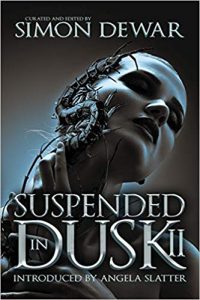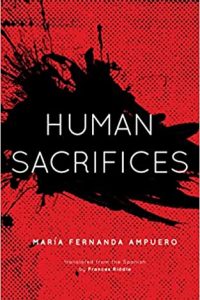Ian Mond Reviews Suspended in Dusk II, Edited by Simon Dewar
 Suspended in Dusk II, Simon Dewar, ed. (Grey Matter Press 978-1940658971, $13.95, 257pp, tp) July 2018.
Suspended in Dusk II, Simon Dewar, ed. (Grey Matter Press 978-1940658971, $13.95, 257pp, tp) July 2018.
It’s shocking that I can’t remember the last time I read a horror anthology. Back in the day – in my late teens and early twenties – horror anthologies were my bread and butter. Whether it was Dark Forces, Prime Evil, Splatterpunks: Extreme Horror (volume 1 and 2), Midnight Graffiti, or Little Deaths, these books introduced me to a whole host of (mostly male) writers including Dennis Etchison, Ed Gorman, Douglas Clegg, Joyce Carol Oates, and Lisa Tuttle. Over the last few years, as my interest in horror waned, I stopped picking up the new crop of anthologies. Simon Dewar’s Suspended in Dusk II provides an opportunity to check-in on the genre and to encounter a new clutch of writers working in the field.
In her introduction, Angela Slatter depicts horror literature as a “history of sharing nightmares.” It’s a description that rings true, that delicious desire to frighten your friends, maybe around the campfire, maybe in a car parked on Lovers’ Lane. While I wasn’t terrified by any of the stories in Suspended in Dusk II – all those years of reading horror has thickened my skin – each author makes a concerted effort to share their vision of a fractured, dark, unforgiving world. As a case in point, the opening story of the anthology, Karen Runge’s “Angeline” is an unsettling portrait of a young woman’s unhealthy desire to attain her father’s love through the men who pay her for sex. Runge’s evocative prose provides no easy answers, just the suggestion of abuse and violence.
While the uncomfortable “Angeline” establishes the overall mood for the anthology, Dewar’s objective to feature a diverse range of writers means that each story hits a different register. In “The Sundowners”, Damien Angelica Walters brilliantly captures the real world horror of dementia, the sense of dislocation, and the mounting paranoia, leading to a chilling ending. Alan Baxter offers up the first overtly supernatural piece with “Crying Demon”, an engrossing and nail-biting riff on that old chestnut, the evil computer game. There’s also room for comedy with Nerine Dorman’s amusing “That Damned Cat” which sees a cabal of devil worshippers accidentally summon a demon into the body of the household feline.
As there is with the tone, there’s a variety of themes laced throughout the collection. The question of mortality and death is at the heart of most the stories, but it’s most evident in pieces like Sarah Read’s “Still Life with Natalie”, J.C. Michael’s “The Immortal Dead” and Bracken MacLeod’s “Lying in the Sun on a Fairy Tale Day.” The MacLeod not only sports the anthology’s best title, it’s also a melancholic meditation on the fragility of life as a hiker, badly injured, trapped and alone on a mountain-top confronts his final moments. Other themes include childhood abuse, which is hinted at in “Angeline”, but explored to its fullest in Gwendolyn Kiste’s “An Elegy for Childhood Monsters” (runner-up for best title). With literal monsters abusing the girls of a small town, the story is a tad on the nose, and yet the manner in which these women, as adults, face their abusers is truly empowering. Stories like Paul Michael Anderson’s wendigo-inspired “Wants and Needs”, Benjamin Knox’s “Mother of Shadows”, and Letitia Trent’s “The Hopeless in the Uninhabitable Places” (third place for best title) deal with the loss of a family member and how this death reverberates and impacts the lives of those still living. That experience of grief is powerfully rendered in “Dealing in Shadows” by Annie Neugebauer, where a daughter is willing to sacrifice her memories, and her identity to spend a few final moments with her recently deceased Dad. Like Bracken MacLeod’s piece, it’s a story that drew me close to tears.
Dan Rabarts’ “Riptide”, my favourite story in the anthology, weaves together the themes noted above, while also emphasising the anthology’s mission statement to promote diverse voices. A father devastated by the disappearance of his wife and two sons believes they were taken by a monster from his childhood. The use of a creature from Maori mythology – the taniwha – adds a richness and authenticity to the piece, further elevated by Rabarts’s description of New Zealand’s coast: the beauty of the shoreline, the pounding of the waves, all of it stained by tragedy and death.
Rounding out Suspended in Dusk II are reprints from Ramsey Campbell, Paul Tremblay, Christopher Golden, and Stephen Graham Jones. While those stories brought back nostalgic memories of anthologies gone by, and while I’m sure the appearance of established, popular writers is a strong selling point, Simon Dewar’s achievement with Suspended in Dusk II is in demonstrating the vibrancy of the field and that the “history of sharing nightmares” is in good hands.
This review and more like it in the November 2018 issue of Locus.
 While you are here, please take a moment to support Locus with a one-time or recurring donation. We rely on reader donations to keep the magazine and site going, and would like to keep the site paywall free, but WE NEED YOUR FINANCIAL SUPPORT to continue quality coverage of the science fiction and fantasy field.
While you are here, please take a moment to support Locus with a one-time or recurring donation. We rely on reader donations to keep the magazine and site going, and would like to keep the site paywall free, but WE NEED YOUR FINANCIAL SUPPORT to continue quality coverage of the science fiction and fantasy field.






